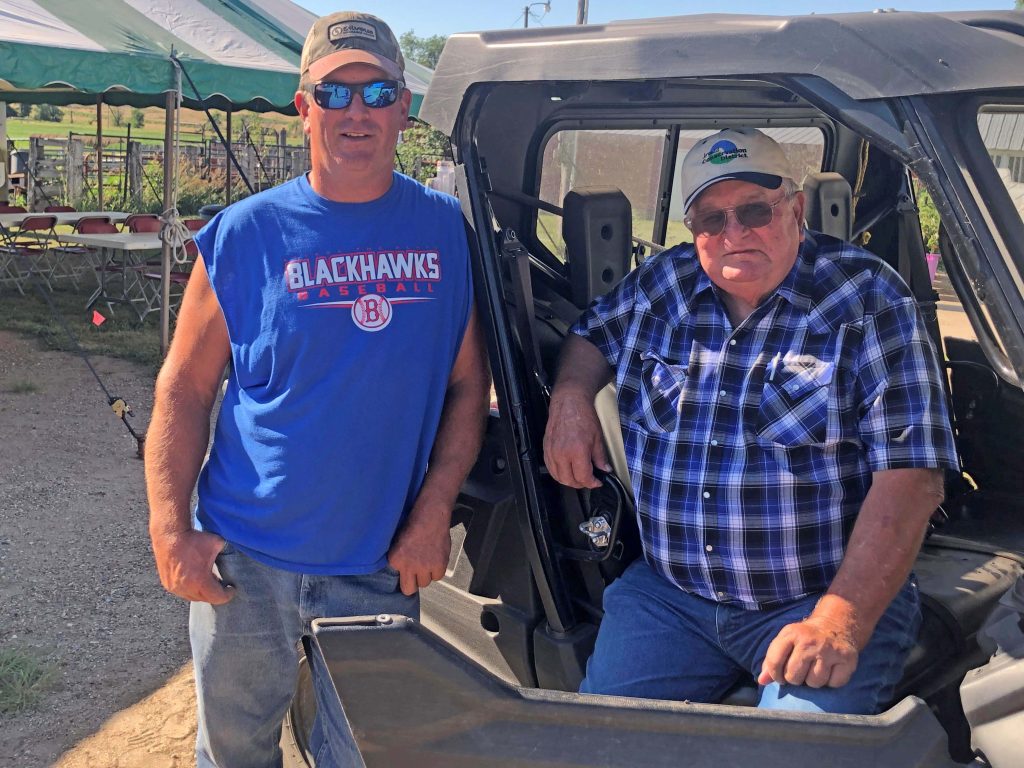Kolousek Family Shares How Soil Health Extends Grazing Season and Keeps Soil from Blowing
By Lura Roti, for South Dakota Farmers Union
If you take care of the soil, it will take care of you, explained fourth-generation Wessington Springs farmer, Dick Kolousek.
“The more we can do to keep the soil productive, the more the soil will produce – even in dry years,” Dick said during a Soil Health Tour held on his family farm and hosted by South Dakota Farmers Union and South Dakota Soil Health Coalition.
Dick raises crops and cattle together with his son, Scott. Scott said although soil health has always been something he and Dick considered – the farm has been no-till for more than 20 years – the men really began focusing on soil building practices about 15 years ago. That’s when they got serious and began:
- Introducing cover crops into their corn and small grain rotation
- Revitalizing dung beetle populations by doing away with pour-on fly insecticide funded partially through Natural Resources Conservation Service (NRCS) Conservation Stewardship Programs
- Intensifying grazing rotations by installing more fencing and water tanks funded partially through Environmental Quality Incentive Program
Scott said the results can be seen throughout their farm – starting with an increase in organic matter. The organic matter is more than 6 percent in fields across the farm. “Increased organic matter means we do not need to apply as much fertilizer on our crop acres – and that saves us money.”

Another cost savings is reduced feed costs. “When I was a kid, we started feeding hay around Thanksgiving,” Scott said. “This last winter our cows were out grazing until the first of February – now granted there wasn’t any snow on the ground. But even with snow on the ground, the cows will dig under the snow to get to grass.”
The Kolouseks typically plant a diverse cover crop mix into wheat stubble mid-July. And it’s ready and waiting when they turn their cows out on it after weaning around the first part of November. “Compared to grazing on corn stalks, the cows really thrive on cover crops,” Scott said.
During the tour, attendees were bused to pastures and had the opportunity to walk through crop fields so they could see the grazing and cover crop rotations firsthand.
Providing an opportunity for farmers to see for themselves how soil health practices work, is the reason South Dakota Soil Health Coalition (SDSHC) asked to host a tour on the Kolousek’s farm.
“Farmers and ranchers are key to improving soil health in South Dakota. Field tours give them the opportunity to see firsthand the successes and failures of others and take back something to make their operation more sustainable,” explained Cindy Zenk, SDSHC Coordinator.
When Zenk called the Kolousek’s to ask if SDSHC could host a tour on their land, Scott said the timing was perfect.
“It was April and the wind was blowing the dirt around – but on our fields, no soil moved. I want to stress to keep soil from blowing it needs to be covered. Cover crops help do that,” Scott explained.
The tour began with a rainfall simulator demonstration to help explain the science behind cover crops’ ability to hold soil as well as moisture.
“A raindrop hits the ground at about 15 to 20 miles per hour,” explained Austin Carlson, SDSHC soil health technician. “When you have a growing cover crop covering the soil, the plants break the impact of these raindrops preventing them from displacing soil particles. Also, the more times we have something actively growing in the soil, the biology of the soil helps bind soil particles together, basically weather proofing it.”
Carlson added that in a healthy grazing system, healthy, strong root systems aid in water infiltration.
Practices to build a healthy grazing system were the focus of many tour discussions. Three years after Rodney Huisman replaced continuous grazing with rotational grazing of his cattle, the NRCS conservationist for Jerauld County saw an increase of 1,000 pounds of grass per acre.
“NRCS standard is take half, leave half. This way the plant leaf can act like a solar panel to take in energy from the sun through photosynthesis and regenerate itself,” Huisman said. “It’s not about the days of grazing. It’s about the days of rest. Healthy plants equal healthy soil.”
Forestburg cattle producer, Joseph Davis agrees. He and his dad, Jack, also implement rotational grazing practices and have seen the benefits. Davis said he attended the soil health tour for the opportunity to gain additional tips to help him fine-tune their existing practices.
“I appreciate organizations hosting tours like this because it gives me and other producers a chance to pick up some new practices and learn from experts and learn from producers how they implement different practices into their system,” Davis said.
Providing South Dakota farmers and ranchers with educational opportunities is a focus of South Dakota Farmers Union and among the reasons the organization partnered with SDSHC to sponsor the tour, explained Karla Hofhenke, executive director of South Dakota Farmers Union.
“Making educational opportunities accessible is one of many ways we work to support our state’s family farmers and ranchers,” Hofhenke said. “We know farmers and ranchers don’t have any time to spare, so we look for quality opportunities, like this soil health tour, to provide them with information to make their time off the farm or ranch worthwhile.”

